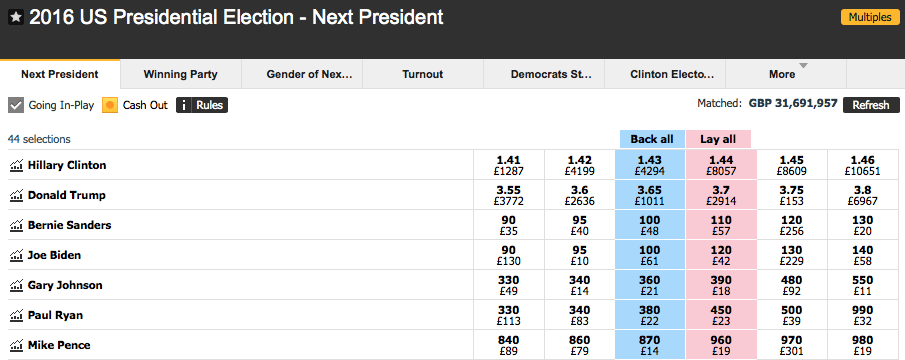
My contacts at TravelZork have been following some write-ups I do about betting on the US Presidential election. I follow the odds of the betting markets more closely than the incessant polls. The betting markets aren’t concerned about personal opinion. Sure there are fans of one candidate or the other who likely make a wager on their “team,” but the BIG money only wants value and is willing to bet either way as long as their model predicts a positive ROI. What this leads to is a “sharp” line where it can be assumed that the odds are true odds, in other words, perfectly predictive of the result’s probability.
Presidential Election
I’ve been asked to give a series on betting on sports and non-sports. There is little difference in the betting aspect of either. Betting on baseball and betting on the election are nearly identical from a procedural standpoint. But since the election is a few weeks away and sports are never-ending, I’ll move to sports after this wild political season has come to a close.
For this series to make sense, an understanding of the process of betting, what the odds mean, and where you can bet is where we need to start, and that is easier using sports as an example.

Underdogs & Favorites
Odds are either PLUS odds or MINUS odds. An UNDERDOG is a person or a team that is predicted to have a lower than 50% chance of winning. A FAVORITE is a person or team that is predicted by the oddsmakers to have a greater than 50% chance of winning. There are unusual times where an event is seen as a true 50/50 toss up, but we’ll save that discussion for another day.
For example, if you had a World Cup soccer match between Germany and the USA. Germany would be the FAV and the USA would be the DOG. The USA would never have a greater than 50% chance of beating Germany in a straight up match, at least not anytime soon.
So the oddsmakers HANDICAP the teams. Germany would have minus odds, and the USA would have plus odds. It might be set up that a $100 bet on Germany, if they won, would only pay $20 profit while a $100 bet on the USA, if they won, would have a $400 profit. While that may seem like a wide spread, it’s actually somewhat reasonable. It estimates about an 80% chance of Germany winning or 4 out of 5. (Yes Germany might be more like 95%, but I’m just trying to illustrate the betting procedure here!)
So If you bet $100 on Germany to win $20 and they win four out of five times, you win $20 four times and then lose $100 for a net of -$20 after five events take place. You can’t play five games at once but these odds are designed to be predictive over the long term. If you bet on the USA, you will lose $100 four times but then win $400 for a net of ZERO after these same five events.
These numbers work out this way because I intentionally chose easy numbers for illustration. Also, the reason that there is an overall NEGATIVE balance is the oddsmakers always have a built-in edge, called the VIG. Their goal is to come out the winner in the long-term, and so they set the odds where some equity is taken out for them.
The Stats
Right now, according to the online site BetFair, Hillary Clinton is the FAVORITE and Donald Trump is the DOG in this race but it’s tightened up significantly. Donald Trump’s odds have come down from a post-Dem convention bounce of +430, to the current number of +255. This is a large move and the difference between the betting market giving him a 19% chance of winning to an improved 28% chance of success in November.
Most sites offering betting on the election are off-limits to people betting within the United States. The only legal one I’m aware of is PredictIt.org. Sites that take customers from other countries that allow betting are PinnacleSports.com and BetFair.com. There are others.
I hope this gave you a taste of what’s to come. Tune in soon for more detailed analysis.
Questions? Join or start a conversation in the comments below.










